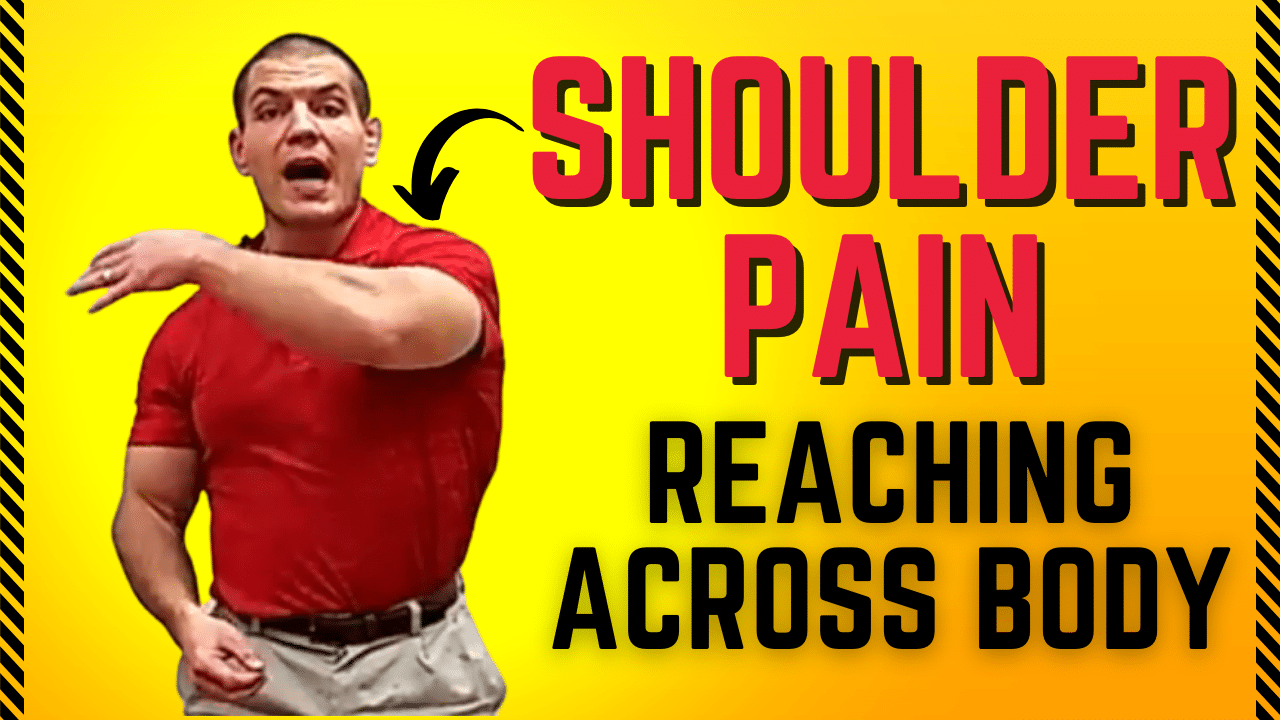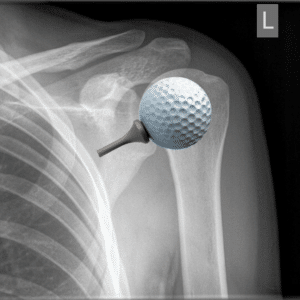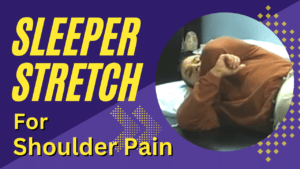Do you get shoulder pain reaching across your body?
Try the 2 tips in this video to keep your shoulder from hurting when reaching across your body.

What Causes Shoulder Pain Reaching Across Body?
Wonder why your shoulder hurts when reaching across your body?
Shoulder pain reaching across your body is usually caused by impingement - meaning pinching or rubbing of a tendon in the shoulder. The specific injuries involved may be:
- Rotator cuff tendonitis
- Rotator cuff tear
- Biceps tedontitis
What Causes These Tendons To Get Pinched?
Reaching across body is commonly difficult for people who have shoulder pain due to stiffness in the back part of the shoulder joint.
When you have stiffness in the back of your shoulder, it causes the ball to glide forward in the socket when you reach across your body.
Why Does That Cause Shoulder Pain?
Well, picture your shoulder joint like a golf ball sitting on a golf tee (except the tee is turned sideways).
Now imagine that your arm is attached to the golf ball.
When the ball is centered in the middle of the tee, your arm will move pretty smoothly.
However, if the ball gets off center, then it can start to pinch on the edge of the tee.
That's sort of what happen when you reach across your body.
The ball of the shoulder glides forward in the socket and you pinch on the front end of the tee.
Additionally, there's a little hook of bone on the front of the shoulder blade call te the coracoid process.
Three muscles attach to the coracoid process:
- your pectoralis minor muscle
- the short head of your biceps
- the coracobrachialis
If the ball of your shoulder is too far forward in the socket, you can also start to pinch the tendons that attach to the coracoid process.
How Do You Stop Shoulder Pain Reaching Across Body?
Here are two tips to keep you shoulder from hurting when reaching acrosss your body:
1. Keep the ball centered in the socket
In order to be able to reach across your body without pain, you need to be able to keep the ball of the shoulder centered in the socket.
As you reach across your body, the ball of the shoulder rolls forward. In order for it to be able to stay centered in the socket, it needs to glide backward at the same time.
If the rotator cuff muscles and joint capsule in the back of the shoulder are too stiff, then the ball won't be able to glide backward.
So how do you keep the back of your shoulder from getting too stiff?
The main two ways to stretch the back of your shoulder are to reach across your body (horizontal adduction), or reach behind your back (internal rotation).
Cross Body Shoulder Stretch
The problem with the first method is that if you're already having shoulder pain reaching across your body, then doing this as an exercise doesn't make sense.
You're more likely to further irritate the problem unless you limit how far across your body that you reach.
One technique shown in the video is to block the ball of your shoulder with your opposite hand while you reach across your body in order to prevent the ball from gliding forward in the socket.
Another option is to lean up against a wall as shown in this video.
Sleeper Stretch For Shoulder Pain
Another exercise that can help if you get shoulder pain reaching across your body is called the sleeper stretch.
Tradiationally, thie exercise is done laying on the side of your sore shoulder and using one hand to push the other arm down toward the floor in the direction of internal rotation.
That doesn't always work well though if the ball of your shoulder isn't centered in the socket.
I've made a modification of this exercise in which you use your opposite hand to keep the ball of the shoulder centered in the socket while you stretch.
Most patients that I've worked with find this variation more comfortable.
Check out my modified version of the sleeper stretch in this post.
Use a Tennis Ball or Massage Ball
You can release the tension in trigger points (or muscle knots) in the back of your shoulder by laying on a tennis ball, racquetball, or trigger point massage ball.
Put the ball behind the shoulder and you'll have to find the sore area. Sometimes it's right behind the shoulder, and other times it's on the shoulder blade where your rotator cuff muscles attach.
You can put the ball up against a wall and hold the ball on the sore area. Or you can put it on the floor and roll around until you find the sore spot on your shoulder blade and hold it there for 60-90 seconds.
Alternatively, you can ask for help from a physical therapist.
Treatments like manual trigger point therapy and dry needling can help release the knots in the back of your shoulder so that you can get rid of your shoulder pain faster.
So that covers the first tip, namely, improving the stiffness in the back of the shoulder.
Now for the second tip on how to reach across your body without your shoulder hurting.
2. Move Your Shoulder Blade
Remember I told you there's a hook of bone on the front of your shoulder blade?
Again, that hook is called the coracoid process.
As you reach across your body, if you don't move your shoulder blade along with your arm, the the ball of your shoulder will eventually run into that hook of bone and start to pinch tendons.
In order to prevent pain reaching across your body, you need to move the shoulder blade along with the arm.
So the axis of rotation shouldn't be right at the shoulder joint. You actually want to move the whole shoulder blade and arm together as you're reaching across your body.
That way, you move the coracoid process out of the way so that you don't pinch tendons as you reach across your body.
Conclusion
So hopefully you found those two tips helpful in order to be able to reach across your body more comfortably. Again those are:
- Keep the ball of your shoulder centered in the socket by decreasing stiffness in the back of the shoulder
- Move the shoulder blade and arm together when reaching across your body.
Need More Help For Shoulder Pain?
Tap the button below to request an appointment with one of our specialists.






